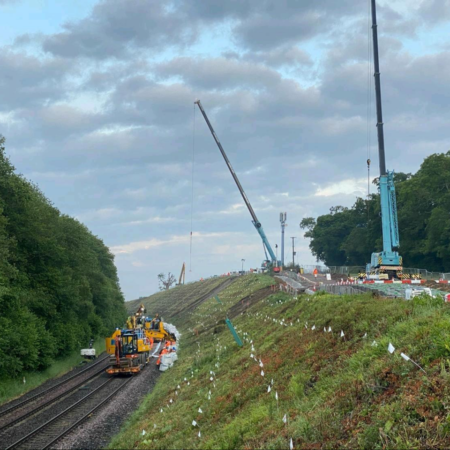Finding A Way – Where Reactive Repairs Meet Lifetime Value
When a catastrophic failure such as a major embankment slip affects the rail network the priority is to get the line open and running again as soon as possible. Maybe there was a time when speed was all that mattered – but today’s transport infrastructure demands more. So contractors have to be flexible and imaginative.
More frequent extreme weather events pose a threat to embankments that may have been built 150 or more years ago. Landslips are fairly common but you can’t predict where or when they will happen.
Rapid Response and a Permanent Solution
When the Ashmead Embankment near Basingstoke failed closing part of the main line, the decision was made to bring forward major improvement works that had been scheduled for the following year. This was made possible by rapidly mobilising a multi-discipline team.
Within two days, the team installed remote track monitoring equipment under possession, supervised delivery of 3,670 tonnes of material for the haul road and piling mat, established a fully-equipped worksite and coordinated 430 HGV deliveries.
Simultaneously, a remote design team involving our specialist partner Arcadis rapidly developed a technical solution that will stand the test of time. Closure was restricted to the slow line during repairs. This lasted nine days, after which the line was handed back with a permanent embankment stabilisation solution in place.
One Blockade, Four Schemes Delivered
Similarly, during a nine-day blockade to repair an embankment at Templecombe in Somerset it was decided to complete a further three schemes at the same time. As well as stabilising the failed embankment, our teams realigned 400m of track at Bugely Bridge to improve resilience and also refurbished two stations.
This all took place during Covid restrictions. This was helpful from the point of view of reduced passenger numbers, but also posed the challenge of maintaining distancing and finding temporary accommodation for over 80 operatives.
Rapid mobilisation of a multi-discipline team allowed the project plan to adapt to unexpected heavy rainfall and changes to the design and sequencing. Six RRV’s, three mobile cranes, two long reach excavators and an engineering train helped to deliver the main works, while extensive support plant fed the other work sites.
This was a lot of activity to pull together and coordinate in a short space of time. The considerable benefit for rail users will be a significant reduction in the need for future closures and disruption.
Working in the modern infrastructure sector calls for more than technical skills, it also demands a culture that looks at apparently conflicting demands (such as speed and lifetime value) and says ‘we’ll find a way.’
To learn more about how Osborne finds a way to deliver added value through projects visit our transport infrastructure resource centre or contact Mike Todd ([email protected]).

